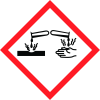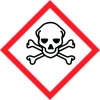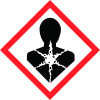Trifluoroacetic acid
Fisher Scientific
Revision date : 2019-06-11



Note: Ingredients listed on restricted chemical lists
EC/CAS
76-05-1
Name of the chemical
Trifluoroacetic acid
Concentration
N/A
General Information
Revision date
2019-06-11
Product name
Trifluoroacetic acid
Product Synonyms
TFA; Trifluoroethanoic acid; Perfluoroacetic acid
CAS No.
76-05-1
Icons in SDS
Company Information
Company name
Fisher Scientific
GHS Information
Signal word
Danger
Section 2
2.1 Classification of the substance or mixture
This chemical is considered hazardous by the 2012 OSHA Hazard Communication Standard (29 CFR 1910.1200) Corrosive to metals Category 1 Acute Inhalation Toxicity - Vapors Category 4 Skin Corrosion/irritation Category 1 A Serious Eye Damage/Eye Irritation Category 1 Specific target organ toxicity (single exposure) Category 3 Target Organs - Respiratory system, Central nervous system (CNS).
Signal word
Danger
Hazard statements
May be corrosive to metals Causes severe skin burns and eye damage May cause respiratory irritation Harmful if inhaled
Prevention
Use only outdoors or in a well-ventilated area Do not breathe dust/fume/gas/mist/vapors/spray Wash face, hands and any exposed skin thoroughly after handling Wear protective gloves/protective clothing/eye protection/face protection Keep only in original container
Response
Immediately call a POISON CENTER or doctor/physician Inhalation IF INHALED: Remove victim to fresh air and keep at rest in a position comfortable for breathing Skin IF ON SKIN (or hair): Take off immediately all contaminated clothing. Rinse skin with water/shower Wash contaminated clothing before reuse Eyes IF IN EYES: Rinse cautiously with water for several minutes. Remove contact lenses, if present and easy to do. Continue rinsing Ingestion IF SWALLOWED: Rinse mouth. DO NOT induce vomiting Spills Absorb spillage to prevent material damage
Storage
Store locked up Store in a well-ventilated place. Keep container tightly closed Store in corrosive resistant polypropylene container with a resistant inliner Store in a dry place
Disposal
Dispose of contents/container to an approved waste disposal plant
2.3 Other hazards
Harmful to aquatic life with long lasting effects

